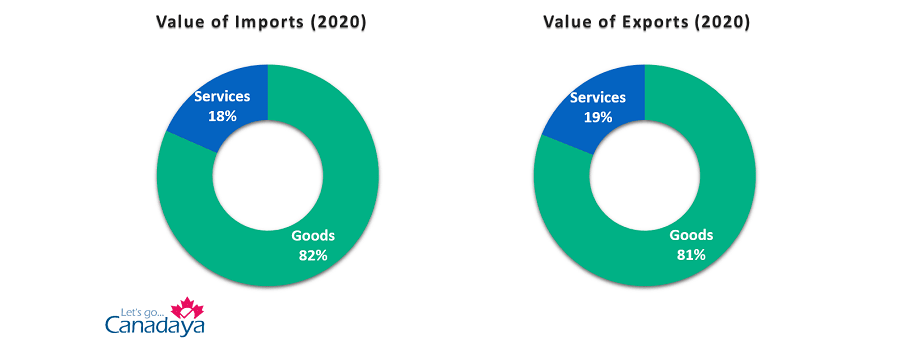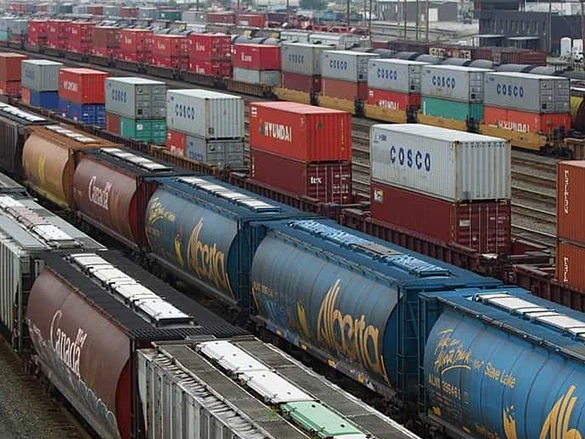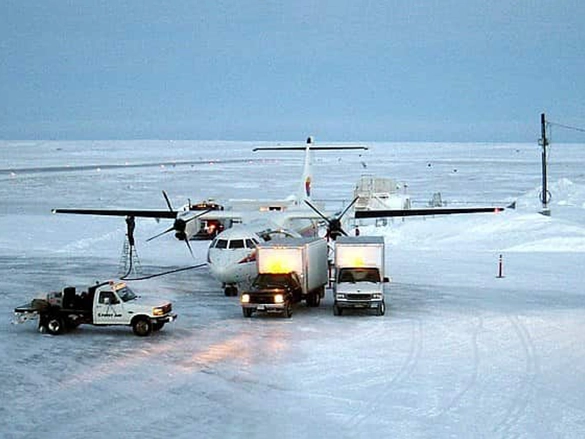
Canada’s trades, a country with trades mostly with its closest neighbor!!

Trading is an important feature of every country’s economy. The number of goods and services imported or exported plays a significant role for other features such as jobs, workforce, national income, etc. Canada is no exception, so, checking on Canada’s economy, you cannot neglect Canada’s trades, imports, and exports.
Here in this article, we discuss Canada’s trades, imports, and exports. We talk about Canada’s business partners and what Canada trades, and in the end, we take a look at the goods transport systems of Canada. So don’t go anywhere until we discuss it all with you!!
Table of Contents
Canada’s trades in a look, how much does Canada trade?
The chart below shows how much Canada has imported and exported goods and services each year in the past decade.
You can see that there has been a rising trend through the decade in Canada’s trades, but in 2020 due to the pandemic, there was a significant drop in the import and export rates. One more point that can be noted is that the difference between imports and exports is comparatively low. Here you can have a better look at the balance between imports and exports in Canada.
Business partners in Canada’s Trades
Canada has been a trading partner of Britain and other western countries throughout its history, but in recent times, its most trades have been with the US. The table below shows Canada’s trading partners in 2020:
As the table shows, the main trading partner in Canada’s trades is the US; more than 60% of the imports and 70% of the exports are done with the US. Also, it’s notable that the rate of imports and exports are relatively close.
Canada has trades, OK, but what does it trade?
Now the question comes to mind, “what does Canada trade?”. To answer this shortly, Canada’s trades, imports and exports are consisted of goods and services. Manufactured products, agricultural crops, etc., are the goods Canada trades.
Importing and exporting services are a bit different; to define it simply, it can be said that “trading services” is to provide a service in a country that one is a resident of, for people or corporations from another country. In the table below, you can see the goods and services imported and exported in Canada.
The larger portion of GDP in Canada is contributed by services, but in exporting and importing matter, goods have the larger portion:
The trades are mostly goods, but how are they transported?
Canada is a vast country, and the goods and services are scattered around its soil. So a proficient transportation system is needed to convey goods and people around Canada. The main transformation systems in Canada are Water, Rail, Motor Carrier, Air, and Pipeline Transportation systems.
Water Transportation: It is mostly used for transporting bulky goods. Because of its nature of having lower speed than other transportation systems, using it for imperishable goods is more proper. It is usually used to transport:
- Coal
- Ore
- Grain
- Gravel
- Salt
The water transportation system is vital for Canada’s trades, for a notable portion of foreign imports and exports are done through it.
Rail Transportation: In addition to transporting people, like water transportation, a rail transportation system is used for moving bulky goods. The key railways in Canada are Canadian National (CN) and Canadian Portal (CP). The relatively low cost of rail transportation and its effectiveness help Canadian products to spread around the country and the world. Rail transportation conveys several types of goods:
- Grain
- Coal
- Lumber
- Ore
- Potash
- Sulfur
Motor Carrier Transportation: In Canada, this form of transportation is done by trucks of different sizes to convey different kinds of goods. Small ones deliver goods to cities and towns. In northern parts, trucks are used to provide various types of goods such as petroleum, logs, etc. The most significant merit of trucks is their versatility; they can reach anywhere that has a highway, road, street, or even just a hard, comparatively flat surface. There are a number of large companies managing truck transportation in Canada, including both Canada’s main railing systems’ trucking divisions. Because of its diversity, this form of transportation should not be neglected when talking about Canada’s trades.
Air Transportation: This method of transportation is mainly used for types of goods that need to be conveyed fast or in areas that access through other forms of transportation is not possible. The 1995 Open Skies Agreement between the US and Canada opened many more opportunities for Air Transportation between the two.
Pipeline Transportation: Pipelines, usually out of sight, are used for transporting gas, petroleum, and other chemical products. Establishing a pipeline needs a relatively low labor force, and keeping it working is not much trouble, so it’s eligible for transport. But there are two things that must be considered; first, a large amount of capital is needed to install a pipeline, and it needs to be working for a long time to be profitable, so a fixed starting point and destination is required for it to be appropriate.
Our last words on Canada’s trades
Canada, a vast country endowed by nature’s blessing and its people’s hard work, has much to offer for trading. Thus Canada’s trades like its industries have an undeniable role in its economic prowess. We hope after reading this article, you have gotten a gist of Canada’s trades and enjoyed it as well.
Here we finish our article on Canada’s trades in hopes of it being useful for you. If you are interested in knowing more about Canada, check our other articles on Geography, Politics, Socio-cultural, and historical aspects of Canada.
- https://www150.statcan.gc.ca/n1/daily-quotidien/210414/t001a-eng.htm
- https://www150.statcan.gc.ca/n1/daily-quotidien/210414/t003a-eng.htm
- https://www150.statcan.gc.ca/t1/tbl1/en/cv.action?pid=1210013001
- https://www150.statcan.gc.ca/t1/tbl1/en/cv.action?pid=1210001101
- https://www150.statcan.gc.ca/n1/daily-quotidien/210414/dq210414a-eng.htm
- https://www.tradeready.ca/2016/trade-takeaways/service-exports-suddenly-important/
- https://www.thecanadianencyclopedia.ca/en/article/transportation
- https://tc.canada.ca/sites/default/files/migrated/transportation_in_canada_2018.pdf
- https://commons.wikimedia.org/wiki/File:Canada_Place,_Container_Port,_Vancouver_2.jpg
- https://commons.wikimedia.org/wiki/File:Canadian_Pacific_Railway_yard,_Port_Coquitlam_BC_-_5946477920.jpg
- https://commons.wikimedia.org/wiki/File:Truck_with_trailer_in_Toronto.jpg
- https://commons.wikimedia.org/wiki/File:UltramarFuelTruck.jpg
- https://commons.wikimedia.org/wiki/File:Unloading_cargo_from_a_First_Air_ATR_42_at_Clyde_River_Airport.jpg
- https://commons.wikimedia.org/wiki/File:Pipeline_CB.jpg
- https://commons.wikimedia.org/wiki/File:Pipeline_suspension_bridge_over














